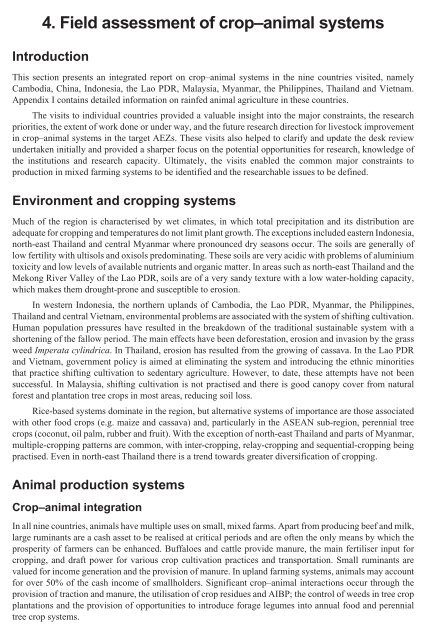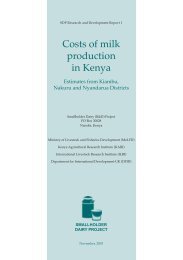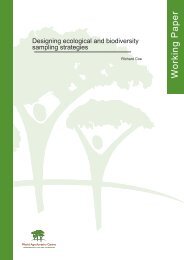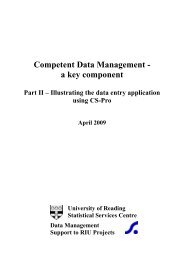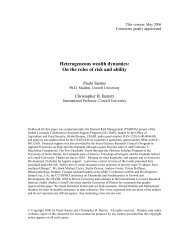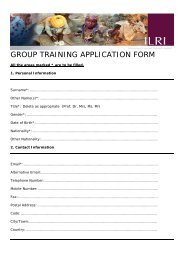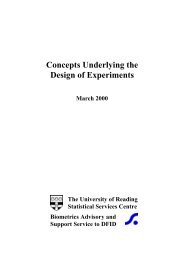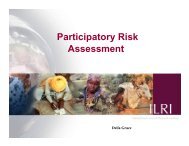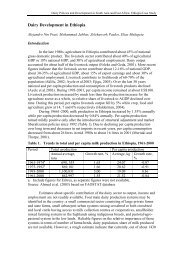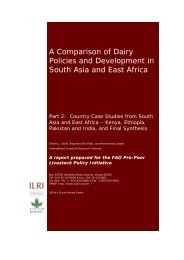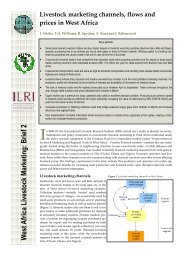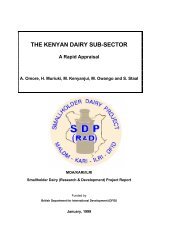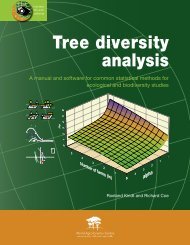4. Field assessment <strong>of</strong> crop–animal systemsIntroductionThis section presents an <strong>in</strong>tegrated report on crop–animal systems <strong>in</strong> the n<strong>in</strong>e countries visited, namelyCambodia, Ch<strong>in</strong>a, Indonesia, the Lao PDR, Malaysia, Myanmar, the Philipp<strong>in</strong>es, Thailand and Vietnam.Appendix I conta<strong>in</strong>s detailed <strong>in</strong>formation on ra<strong>in</strong>fed animal agriculture <strong>in</strong> these countries.The visits to <strong>in</strong>dividual countries provided a valuable <strong>in</strong>sight <strong>in</strong>to the major constra<strong>in</strong>ts, the researchpriorities, the extent <strong>of</strong> work done or under way, and the future research direction for livestock improvement<strong>in</strong> crop–animal systems <strong>in</strong> the target AEZs. These visits also helped to clarify and update the desk reviewundertaken <strong>in</strong>itially and provided a sharper focus on the potential opportunities for research, knowledge <strong>of</strong>the <strong>in</strong>stitutions and research capacity. Ultimately, the visits enabled the common major constra<strong>in</strong>ts toproduction <strong>in</strong> mixed farm<strong>in</strong>g systems to be identified and the researchable issues to be def<strong>in</strong>ed.Environment and cropp<strong>in</strong>g systemsMuch <strong>of</strong> the region is characterised by wet climates, <strong>in</strong> which total precipitation and its distribution areadequate for cropp<strong>in</strong>g and temperatures do not limit plant growth. The exceptions <strong>in</strong>cluded eastern Indonesia,north-east Thailand and central Myanmar where pronounced dry seasons occur. The soils are generally <strong>of</strong>low fertility with ultisols and oxisols predom<strong>in</strong>at<strong>in</strong>g. These soils are very acidic with problems <strong>of</strong> alum<strong>in</strong>iumtoxicity and low levels <strong>of</strong> available nutrients and organic matter. In areas such as north-east Thailand and theMekong River Valley <strong>of</strong> the Lao PDR, soils are <strong>of</strong> a very sandy texture with a low water-hold<strong>in</strong>g capacity,which makes them drought-prone and susceptible to erosion.In western Indonesia, the northern uplands <strong>of</strong> Cambodia, the Lao PDR, Myanmar, the Philipp<strong>in</strong>es,Thailand and central Vietnam, environmental problems are associated with the system <strong>of</strong> shift<strong>in</strong>g cultivation.Human population pressures have resulted <strong>in</strong> the breakdown <strong>of</strong> the traditional susta<strong>in</strong>able system with ashorten<strong>in</strong>g <strong>of</strong> the fallow period. The ma<strong>in</strong> effects have been deforestation, erosion and <strong>in</strong>vasion by the grassweed Imperata cyl<strong>in</strong>drica. In Thailand, erosion has resulted from the grow<strong>in</strong>g <strong>of</strong> cassava. In the Lao PDRand Vietnam, government policy is aimed at elim<strong>in</strong>at<strong>in</strong>g the system and <strong>in</strong>troduc<strong>in</strong>g the ethnic m<strong>in</strong>oritiesthat practice shift<strong>in</strong>g cultivation to sedentary agriculture. However, to date, these attempts have not beensuccessful. In Malaysia, shift<strong>in</strong>g cultivation is not practised and there is good canopy cover from naturalforest and plantation tree crops <strong>in</strong> most areas, reduc<strong>in</strong>g soil loss.Rice-based systems dom<strong>in</strong>ate <strong>in</strong> the region, but alternative systems <strong>of</strong> importance are those associatedwith other food crops (e.g. maize and cassava) and, particularly <strong>in</strong> the ASEAN sub-region, perennial treecrops (coconut, oil palm, rubber and fruit). With the exception <strong>of</strong> north-east Thailand and parts <strong>of</strong> Myanmar,multiple-cropp<strong>in</strong>g patterns are common, with <strong>in</strong>ter-cropp<strong>in</strong>g, relay-cropp<strong>in</strong>g and sequential-cropp<strong>in</strong>g be<strong>in</strong>gpractised. Even <strong>in</strong> north-east Thailand there is a trend towards greater diversification <strong>of</strong> cropp<strong>in</strong>g.<strong>Animal</strong> production systems<strong>Crop</strong>–animal <strong>in</strong>tegrationIn all n<strong>in</strong>e countries, animals have multiple uses on small, mixed farms. Apart from produc<strong>in</strong>g beef and milk,large rum<strong>in</strong>ants are a cash asset to be realised at critical periods and are <strong>of</strong>ten the only means by which theprosperity <strong>of</strong> farmers can be enhanced. Buffaloes and cattle provide manure, the ma<strong>in</strong> fertiliser <strong>in</strong>put forcropp<strong>in</strong>g, and draft power for various crop cultivation practices and transportation. Small rum<strong>in</strong>ants arevalued for <strong>in</strong>come generation and the provision <strong>of</strong> manure. In upland farm<strong>in</strong>g systems, animals may accountfor over 50% <strong>of</strong> the cash <strong>in</strong>come <strong>of</strong> smallholders. Significant crop–animal <strong>in</strong>teractions occur through theprovision <strong>of</strong> traction and manure, the utilisation <strong>of</strong> crop residues and AIBP; the control <strong>of</strong> weeds <strong>in</strong> tree cropplantations and the provision <strong>of</strong> opportunities to <strong>in</strong>troduce forage legumes <strong>in</strong>to annual food and perennialtree crop systems.
Various animal production systems that <strong>in</strong>volve both rum<strong>in</strong>ants and non-rum<strong>in</strong>ants mostly <strong>in</strong>tegratedwith crops are found <strong>in</strong> these countries. The systems vary <strong>in</strong> relation to AEZs, feed availability, the <strong>in</strong>tensity<strong>of</strong> the mixed farm<strong>in</strong>g operations and response to market opportunities. The new open-market policies <strong>of</strong> theMekong countries are hav<strong>in</strong>g a pr<strong>of</strong>ound effect on these systems. The relative populations <strong>of</strong> <strong>in</strong>dividualanimal species are dependent on their <strong>in</strong>dividual functions, the demand for food products, and their socialvalue. Large rum<strong>in</strong>ants are kept <strong>in</strong> all ra<strong>in</strong>fed rice-based systems <strong>in</strong> every country, whereas small rum<strong>in</strong>antsare found only <strong>in</strong> some. Where root crops are grown, production <strong>of</strong> pigs and chicken is common, e.g. onLeyte (Visayas island group) <strong>in</strong> the Philipp<strong>in</strong>es, <strong>in</strong> the north-east region <strong>of</strong> Thailand, and <strong>in</strong> many parts <strong>of</strong>Cambodia, South Ch<strong>in</strong>a and Vietnam. Ducks are more common where there is stand<strong>in</strong>g water and significantnumbers were observed <strong>in</strong> Indonesia, South Ch<strong>in</strong>a, Thailand and Vietnam.Whilst rum<strong>in</strong>ant populations are greater and more widespread <strong>in</strong> the production systems <strong>in</strong> the ASEANsub-region, non-rum<strong>in</strong>ants play a more significant role <strong>in</strong> the Mekong River countries and <strong>in</strong> South Ch<strong>in</strong>a.Without exception, pigs are the most important animals <strong>in</strong> all Mekong countries, followed by chicken andrum<strong>in</strong>ants. However, this does not reduce the relative importance <strong>of</strong> any species <strong>in</strong> any country and all animalsperform both primary and secondary functions. Throughout the Mekong countries and South Ch<strong>in</strong>anon-rum<strong>in</strong>ant production systems, based on technology from developed countries (improved breeds,concentrate feed<strong>in</strong>g, <strong>in</strong>door rear<strong>in</strong>g on concrete and use <strong>of</strong> vacc<strong>in</strong>es), are function<strong>in</strong>g without problems. Thereare no priority researchable issues to be addressed.Non-rum<strong>in</strong>ants and fish are <strong>of</strong>ten <strong>in</strong>tegrated <strong>in</strong> a variety <strong>of</strong> comb<strong>in</strong>ations with both annual and perennialcrops. This was especially evident <strong>in</strong> Indonesia, the Philipp<strong>in</strong>es, South Ch<strong>in</strong>a and Vietnam. Rum<strong>in</strong>ants mayor may not be <strong>in</strong>cluded <strong>in</strong> these <strong>in</strong>tegrated systems. Examples <strong>of</strong> such systems are:• Indonesia: Rice–fish–duck–goats• Philipp<strong>in</strong>es: Rice–buffaloes–pigs–chicken–ducks–fruit trees–fish• South Ch<strong>in</strong>a: Rice–maize–pigs–vegetables–sweet potatoes–dairy cattle• Thailand: Rice–fish–pigs–ducks–vegetables• Vietnam: Pigs–ducks–vegetables–fruit trees–fish–goats.These <strong>in</strong>tegrated systems <strong>in</strong>volve the use <strong>of</strong> some resources and different sub-systems which result <strong>in</strong>a variety <strong>of</strong> <strong>in</strong>teractions. There are two ma<strong>in</strong> aspects <strong>of</strong> this <strong>in</strong>tegration which merit comment. Firstly, notenough is known about the rationale and methodologies used to match the sub-systems, the effects <strong>of</strong> their<strong>in</strong>teractions, or the economic and environmental impacts. Secondly, <strong>in</strong> all countries visited, with the exception<strong>of</strong> South Ch<strong>in</strong>a, these <strong>in</strong>tegrated systems operate more at the subsistence level, with considerable potentialfor further <strong>in</strong>tensification and <strong>in</strong>creased total production <strong>in</strong> the future. Rum<strong>in</strong>ant production systems <strong>in</strong> then<strong>in</strong>e countries fall <strong>in</strong>to three major categories.Extensive systemsThese are low-<strong>in</strong>put and low-output systems, with less opportunities for development through improvedtechnology use.<strong>Systems</strong> comb<strong>in</strong><strong>in</strong>g arable cropp<strong>in</strong>g and pasturesResidues and AIBP from arable cropp<strong>in</strong>g comb<strong>in</strong>ed with native grasses from roadsides, wasteland, stubblegraz<strong>in</strong>g or improved pastures. <strong>Animal</strong>s graze freely, are tethered or kept <strong>in</strong> conf<strong>in</strong>ement. crop–animal<strong>in</strong>teractions are particularly important <strong>in</strong> these systems, and the opportunities for <strong>in</strong>terventions are significant.<strong>Systems</strong> <strong>in</strong>tegrated with perennial tree cropsThese tree crops <strong>in</strong>clude coconut, rubber, oil palm and fruits.It is quite likely that there will be <strong>in</strong>creas<strong>in</strong>g <strong>in</strong>tensification and a shift with<strong>in</strong> some <strong>of</strong> these systems(especially from extensive systems to those comb<strong>in</strong><strong>in</strong>g arable cropp<strong>in</strong>g and stall-feed<strong>in</strong>g) <strong>in</strong>duced by humanpopulation growth and the decl<strong>in</strong>e <strong>in</strong> availability <strong>of</strong> arable land.
- Page 2 and 3: Affiliation of Authors:Dr C. Devend
- Page 4 and 5: 6.Strategyfor researchJustification
- Page 7 and 8: AcknowledgementsThe International L
- Page 9 and 10: esearch opportunities appropriate t
- Page 11 and 12: Table 1.Animal populations and meat
- Page 13 and 14: Introduction2. Characterisation and
- Page 15 and 16: Figure 2. Sub-humid tropics and sub
- Page 17 and 18: Table 3.Human and animal population
- Page 19 and 20: Table 5. Rice-growing environments
- Page 21 and 22: Multiple upland annual crop systems
- Page 23 and 24: Table 6. Continued.Country Importan
- Page 25 and 26: It should be noted that, compared w
- Page 27 and 28: Table 8.CountryCambodiaChinaIndones
- Page 29 and 30: of non-renewable fossil fuels and t
- Page 31 and 32: Overview of researchThere was a sur
- Page 33: • Identification of alternative c
- Page 37 and 38: Presently, much of the vegetable pr
- Page 39 and 40: Table 10. Summary of the main socio
- Page 41 and 42: Table 11. Institutions and organisa
- Page 43 and 44: 3. In the ASEAN sub-region, inadequ
- Page 45 and 46: Table 12. Continued.SituationsPract
- Page 47 and 48: 6. Strategy for researchJustificati
- Page 49 and 50: Table 13. Priorities for research a
- Page 51 and 52: VietnamResearch capacity in NARS is
- Page 53 and 54: CRIFC (Central Research Institute f
- Page 55 and 56: IAS. 1995. Proceedings of the Works
- Page 57 and 58: Systems of sub-Saharan Africa. Volu
- Page 59 and 60: or waterlogged in the wet season an
- Page 61 and 62: Table A1. Important diseases of ani
- Page 63 and 64: • Increased cropping intensities,
- Page 65 and 66: the animal output came from pigs al
- Page 67 and 68: 18-21° North, with an average rain
- Page 69 and 70: In the Nusa Tenggara islands, signi
- Page 71 and 72: Women work 11.5 h/day on average co
- Page 73 and 74: Various Australian forage projects
- Page 75 and 76: village production systems; to stud
- Page 77 and 78: The availability of feed in rubber
- Page 79 and 80: of the Ayeyarwady and Sittang river
- Page 81 and 82: Constraints and opportunitiesInadeq
- Page 83 and 84: gaining in importance, and signific
- Page 85 and 86:
Table A3. Characterisation of crop-
- Page 87 and 88:
Table A4. Interventions in crop-ani
- Page 89 and 90:
Table A4. Continued.Project TitleGo
- Page 91 and 92:
otations are practised, and there a
- Page 93 and 94:
such as abortion. Vaccination cover
- Page 95 and 96:
large areas of forests (3.4 million
- Page 97 and 98:
Table A6. Some animal diseases repo
- Page 99 and 100:
Appendix IIItineraryThe Philippines
- Page 101 and 102:
26 November 1996 am Visit to small
- Page 103 and 104:
Appendix IIIList of persons metPhil
- Page 105 and 106:
Mr Chhiv Nan, Acting Director, Depa
- Page 107 and 108:
Dr U Maung Ngint, Managing Director
- Page 109:
List of acronymsAARDACIARADBAEZAIBP


